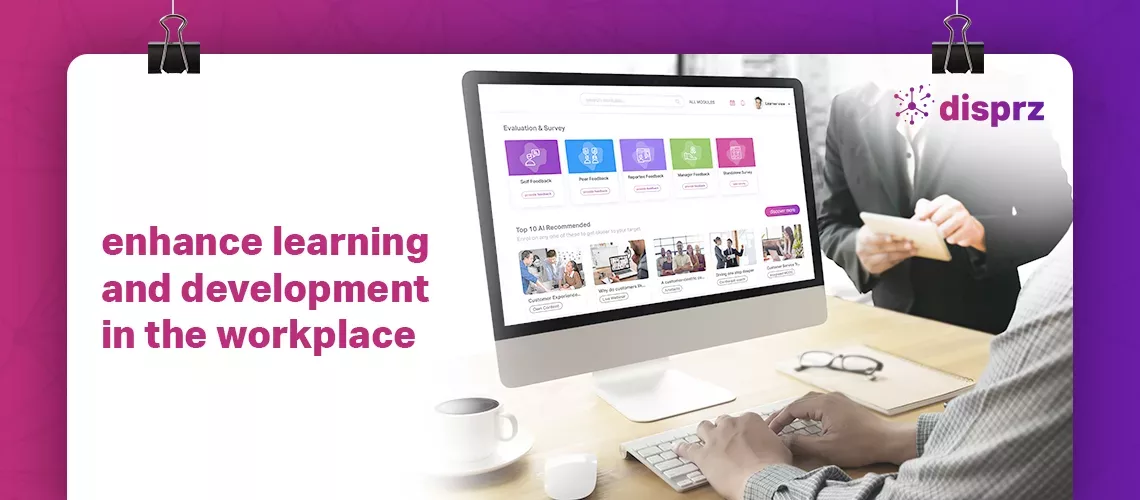As per CNBC’s research, 94% of employees say that they would stay at a company longer if it simply invested in helping them learn. The statistics clearly convey how critical workplace learning is for employee retention. It is the most powerful tool to keep your best talents and upskill them to deliver high-quality performance for driving business growth.
Hence big names in the Industry are investing in workplace learning to upskill the employees.
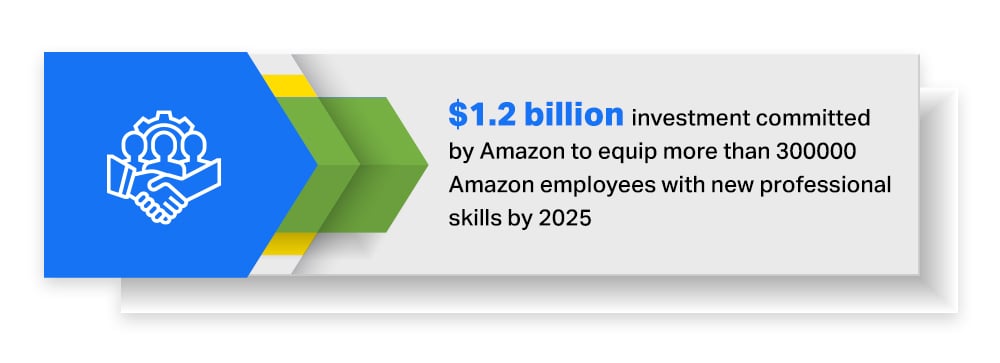
Do you know workplace learning can do much more than just strengthen employee skill sets? It can prevent employee burnout, improve employee engagement, attract top talent, and ultimately boost your business’s bottom line. However, to achieve workplace learning success, it is crucial to implement it correctly. Without much ado, let’s look at all aspects of workplace learning to find out what didn’t work in 2022 and which L&D strategies can be improved to make learning in the workplace more effective in 2023.
What is workplace learning?
Workplace learning is a structured process that focuses on developing the competencies and skills of the employee. It is designed to bridge the performance gap and amplify workplace productivity. Workplace learning gives employees the opportunity to advance in their careers and contribute substantially to a company’s growth.
Workplace training is aimed at unlocking employees’ full potential, making them agile, and nurturing them to grow holistically into leaders of tomorrow. From an employee immersing in online resources in an asynchronous setup to instructors conducting collaborative sessions for teams, workplace learning can take place in different ways. To ensure workplace learning and development effectiveness, it needs to be planned strategically.
Benjamin Franklin rightly said, “An investment in knowledge pays the best interest.”
Hence companies globally are making workplace learning a part of a company’s investment and growth strategy.
The Importance of Training & Development in the Workplace
Employees are the powerhouse of any organization; empowering them to hone their skills to progress professionally will only add to the company’s success. Workplace learning isn’t confined to employee development; at a broader level, it makes a company more competitive, progressive, innovative, and adaptable to respond to unforeseen challenges.
Training and development are important in the workplace as they enable employees to
-
Exhibit their hidden talent
-
Address changing customer needs
-
Embrace the latest skills to stay relevant in an evolving business environment
-
Accomplish more goals with the least effort and errors
-
Address new challenges with utmost confidence
-
To not feel stagnant and be engaged at work
-
Achieve operational efficiency
-
Bounce-back from failures and perform better
Benefits of workplace learning
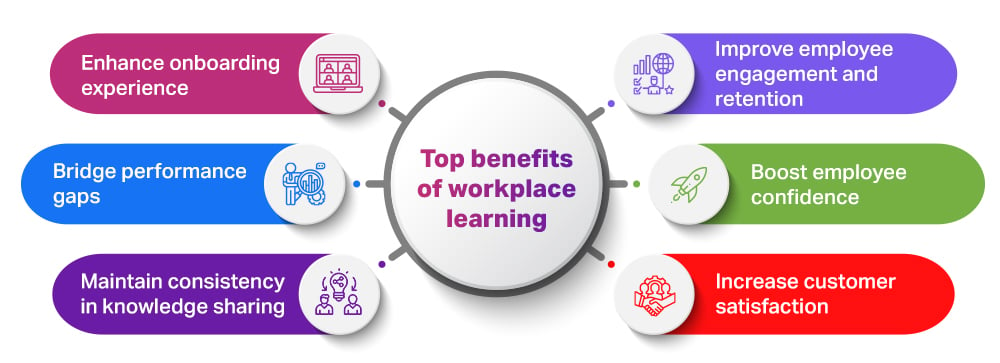
Modern workplace learning helps transform employee performance and serves a catalyst for growth. Well, these are just two benefits; there are several more. Read on to find the several advantages of workplace learning.
Best onboarding experience
Workplace learning helps deliver a great onboarding experience to make employees job-ready quickly.
As per research, 70% of employees who had exceptional onboarding experiences claim they have ‘the best possible job.’ These employees are also 2.6 times as likely to be extremely satisfied with their workplace and far more likely to stay.
A structured onboarding process can help employees blend into the company culture rather than feeling alienated at work. Training and development should start from the very first day to help employees get up to speed quickly and improve time to productivity.
Bridge performance gaps
Performance gaps can affect individual, team, and company goals. Timely intervention through workplace training can help address the problem areas on time.
In a well-designed workplace learning infrastructure, performance goals are set and measured regularly to give employees a reality check of their performance goals. The missing skills are identified through skill gap assessment, and the learning journey is defined to bridge the skill gap and improve performance. Employees have a clear direction of what is expected of them and what skills they need to hone to climb up the career ladder.
Maintain consistency in knowledge sharing
Your company’s brand language helps you stand out in the crowd. So be it a marketing or a sales team, everyone should convey the same brand message and maintain consistency while sharing information about the company or product.
Workplace learning can help disseminate the same information across the organization to ensure everybody is on the same page and shares the same information while communicating with a potential buyer or an existing customer.
Improve employee engagement and retention
Engaged employees are enthusiastic about fulfilling their job responsibilities and tend to deliver positive results. They exhibit loyalty to their work and the company. Hence employee engagement is no more an option but the need of the hour for improving workplace retention.
Today’s modern workforce needs on-the-job development to stay longer in a company. As per Havard Business Review’s research, 86% of professionals said that they would change jobs if a new company offered them more workplace learning opportunities for professional development.
Making learning a part of employees’ everyday work can boost engagement and help in skill development. Employees reciprocate with great performance when a company displays interest in its growth.
Boost employee confidence
Robust training and development help makes employees more confident. An in-depth understanding of the product and procedures help employees in painting a positive picture of the company without hesitation.
The confidence pushes employees to perform better and move beyond their comfort zone to excel at their job. Moreover, it even fosters a sense of enthusiasm for achieving the goals.
Increase customer satisfaction and get better business results
A negative review by a customer about poor quality work or bad service can go viral in minutes and affect the reputation of a company. In contrast, positive word of mouth helps in attracting more buyers.
Employee performance has a major effect on customer satisfaction. Equipping the workforce with relevant knowledge can strengthen them to meet customer expectations and contribute to achieving better business results. With the right training, employees can attract the right target audience, convert potential buyers into loyal customers, resolve client issues quickly and drum up the company’s revenue.
2022’s common Training Challenges identified by the L&D leaders across different regions
The best person to narrate a story is the one who experiences it. Let’s find out the top challenges of 2022 and what L&D professionals did to address them. Disprz, in association with ETHR world, interviewed several L&D experts across various regions and came up with an insightful e-book, “War for talent,” that addresses various L&D challenges. We’ve skimmed the top L&D challenges and highlighted the solutions as well as experiences shared by the L&D experts of reputed companies across the world.
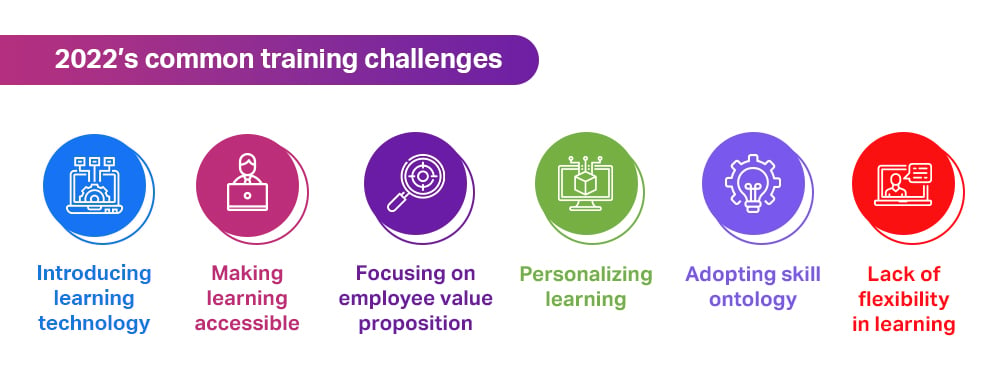
Introducing learning technology in the organization
Most companies are still clinging to age-old techniques for training their employee, which results in unsatisfactory results. Today’s fast-moving business world calls for change. Companies need to explore technology that facilitates knowledge at a limitless scale.
Norlida Azmi, Group CHRO, shares how Axiata Group Berhad merged learning with technology to encourage learning and knowledge sharing at scale.
“As an organization that wants to be the next generation of digital champions, we have prioritized digital and technological academies. We implemented various online academics to ensure employees learn what they want to learn when they want to learn and also balance it with what they need to learn. Technology can act as a great platform to collaborate and share learning with each other. ”
Making learning accessible and consumable
As businesses expand their footprint in different countries, keeping the distributed workforce updated and upskilled becomes challenging. Companies must ensure that employees in different time zones receive the same learning experiences and translate learning into productive outcomes.
Gurkirandeep Singh, Head-Talent Management Learning and Organizational Development Titan Company, shares how they make learning accessible and consumable for their distributed workforce- “When it comes to distributed learning, our idea is to make it available to everyone and make learning democratized. However, the challenge today is not about making it available but making it consumable. According to our learning strategy, there are three tenets to making a successful learning experience – making learning available, consumable and implementable.”
Making learning a part of employees’ value proposition
Companies no longer have the upper hand in retention. Employees are surrounded by several options. For a company to grow, it is crucial to keep employee development at the center and deliver on employee value position. Unfortunately, most companies fail to pay attention to EVP while delivering workplace learning.

Aarti Srivastava, Chief Human Resource Office, Capgemini India, shares how they’ve focused on EVP. ”Organizations will need to create an employee proposition, which is both centric to the employee and the organization. As HR leaders, we need to know the culture and needs of the organization and accordingly propose the EVP. For us as an organization, our value proposition focuses on continuous learning and growth opportunities.”
Personalizing learning to address the skill disruption
While implementing workplace learning, most companies take a generic approach to learning and development that fails to bridge the skill gap. The skill gap differs from employee to employee. A shoe that fits one might pinch the other. Hence instead of taking a one size fits all approach, it is crucial to personalize learning to address the skill disruption.
Companies like HDFC life have made personalization a part of their employee skillings strategy to empower employees with the right skills. Chandrani Chatterjee, Senior Vice President, Learning and Development HDFC Life, shares,
“The learning intervention in our company is completely personalized. We don’t subject every employee to all kinds of training. Different departments and roles require different skills and knowledge. So, we take a very focused approach and analyze what the employees require. Accordingly, we invest in their learning and development.
Adopting skill ontology and building a skill inventory
Skills are changing and have a very short shelf life. Hence it is crucial to create a skill inventory for every role in the company. However, unfortunately, this is a once-in-a-year task in some companies that widens the skill gaps in employees. Well, there are even organizations like Emirates National Oil company that have developed great talent by making skill identification and skills development a continuous process.
Manish Mohan Misra, Group Head – Hr Transformation, Emirates national Oil company shares,
“It is pivotal to adopt a skill ontology and build a skill inventory. These skill ontologies could be related to industries, or it could be company specific, but it is required so you know that you have an inventory that tells you the skill you have and the ones you will need. This creates a way for reskilling, upskilling, or cross-skilling for your employees. A company needs to start to look at skill inventory capturing on a continuous basis in the flow of work. The strategic workforce planning function has to evolve and mature from being done once a year to a more continuous one, and it has to capture insights around skills and the skill gap that the organization has.
Lack of flexibility in learning
Most companies are still following the synchronous way of learning that bounds employees to a specific time and place. Modern employees are on their toes due to a wide array of tasks on their plates. They need the flexibility to dedicate time to learning. Let’s see how Pepsico nurtured a continuous learning culture by integrating flexibility into their everyday learning at work.
Marie Louise EK, Global People leader, Pepsico, UAE, shares,
“We embedded flexibility into different facets of an employee’s day-to-day activities. A learning platform that offers candidates the flexibility to drive their own learning paths has become a necessity.”
12 Workplace learning Strategies[based on the trends we see] to achieve success in 2023
A workplace learning strategy helps the L&D team to have a clear vision of the path ahead to build employees’ skills, capabilities, and competencies. It also enables the top management to see if the L&D initiatives are aligned with the overall corporate goals and strategies. Here are a few effective workplace training strategies based on the workplace learning trends we observed that help create the roadmap to achieve success in 2023.
Conduct a skill gap assessment
As per ICIMS research, the skills gap could create an $8.5 trillion deficit in revenue over the next decade. The evolution of technologies, the shift in resources, and changes in the marketplace have created a void between the skills that the employees possess and the ones that the job role requires.
For instance, skills like business environment analysis, cybersecurity, data governance, digital risk assessment, emerging technology synthesis, risk data integrity are required to succeed as a network security engineer. However, Syria being in the same role, only possess cybersecurity, data governance, and digital risk assessment skills that affect her performance and even have an impact on the company. Through skill gaps assessment, it is possible to find the missing skills and even the proficiency level of the current skills.
A skill gap assessment helps a company outline the desired future state and the current skills with an aim to find critical gaps that may affect the employee’s performance and the overall business bottom line. Regular skill gap assessment reveals patterns of goal attainment and underperformance within the organization. Moreover, it even indicates an organization’s health and capability.
How to conduct skil gap asessement?
-
Create a skill inventory for each role in the organization
-
Evaluate employee’s proficiency level for each skill through skill score
-
Conduct self, peer, and manager assessments to find out the skill score
-
Based on the score, make a list of missing skills and the existing ones that need attention
-
Accordingly, design a learning program to bridge the gaps
Encourage L&D to prioritize their own learning
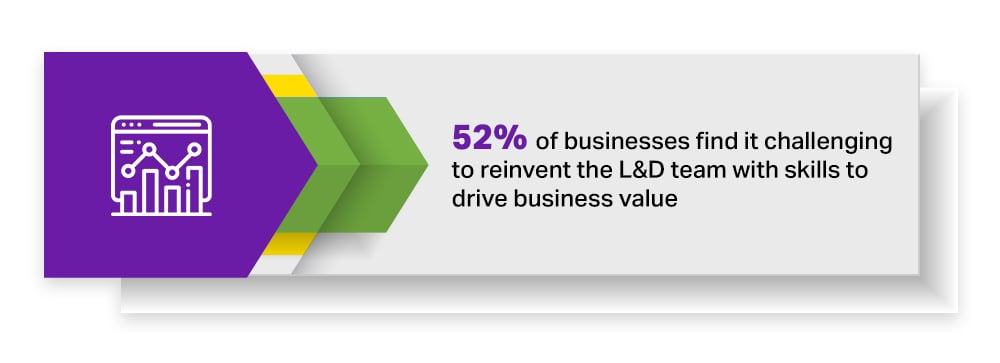
John F. Kennedy rightly said, “Leadership and learning are indispensable to each other.” The L&D professionals are like the captain of the ship. To navigate the employees in the right direction, they need to be exceptional leaders backed with the right skills. So companies need to focus on training the trainer and motivating the L&D leader to prioritize their own development for providing the best learning experiences to the employees. The L&D leader must keep pace with advancing technology and stay updated with the changes and development in their niche.
Below are the essential skills that an L&D professional must develop:
-
Presentation skills
-
Communication skills
-
Analytical skill
-
Training design skill
-
Critical thinking skill
-
Leadership skill
Apart from the above, the skills the L&D professionals should be trained to
-
Act as a consultant for the business
-
Emerge as a powerful facilitator
-
Build comfort with digital learning
-
Focus on the context before content
-
Measure the learning outcomes
With an end-to-end skilling suite like Disprz, the L&D head can effortlessly upskill employees as well develop the required skills themselves.
Assess and mitigate scrap learning
Most L&D professionals reuse the learning courses that employees didn’t access, complete, or implement to improve performance. What’s the point of keeping courses in the learning journey that the employees won’t consume or apply to work? It just leads to a waste of time and money.
For instance, the training cost for an organization is $10000 but employees only complete and use 60% of the information they learned. So 40% of content would be considered scrap, costing around $4000 to the company.
So, it is imperative to track and eliminate the scrap content on time instead of forwarding it to next year. Create a process where before the financial year ends, the L&D professionals dedicate at least three weeks to assess, identify and move out content from the learning journey that’s not consumed or applied to work.
Listen to the learners through one-to-one conversation
As a customer’s thoughts about a product are pivotal; similarly, the learners’ views about the learning and development courses are of paramount importance. The learner’s sentiments and interests should be the fundamentals for designing engaging learning programs. Therefore it is crucial to have one-to-one conversations with the learner and listen attentively to:
-
Uncover the learner’s intent and expectations.
-
Understand if the learners are absorbing a significant amount of information
-
Discover the disconnect between learning programs and learner’s needs
-
Identify the root causes that are holding the learner from completing the courses
-
Develop engaging programs that the learner will be enthusiastic about
Ensure constructive review
Giving constructive review is as important as listening to the learners. Employees need regular check-ins for detailed insights into learning progress and the hurdles that are affecting their performance. Constructive review can help in boosting the growth, and overall development of the employee
So:
-
Conduct various objective and subjective assessments
-
Discuss the assessment scores with the learners
-
Provide feedback on what’s the impact of learning on performance
-
Share specific solutions and suggestions to address the improvement areas
Create learning champions
As per a study by the training industry, one-third of learning leaders have trouble securing a champion for training at their organization.
Wondering who are learning champions? Well, learning champions can be anyone from the organization who masters the skills and promote skilling throughout the organization.
Learning champions help sustain the learning culture. They motivate others to learn and even help bring the mindset shift towards skill development. Learning champions help identify the skill gaps and even show the way forward to bridge them. Ideally, every team in the organization should have one learning champion.
Lay out the roles and responsibilities of a learning champion to ease out the process of selecting a champion for each time. Either through teammates or manager nomination, create a list of potential candidates and assess them to select the best who can embrace their own learning experience and share them with others.
Embrace a workplace learning tool like LXP
A learning and development system like the LXP platform can positively change the workplace learning environment and make it more lively through personalization. If you have implemented it yet, then you should surely consider exploring it in 2023. It can provide a Netflix-like experience where employees get recommendations based on their interests and past learning behavior. It is the best way to provide learning at the right time and place without employees needing to search for it.
An advanced tool like Disprz LXP enables L&D leaders to:
-
Speed-up skill building by enabling them to identify and develop the right skills
-
Focus on role-based learning
-
Make learning relevant through AI-based personalization
-
Assess learning ROI and skilling progress through skill score and role score analytics
-
Slice and dice insights as per the business’s unique learning needs
-
Create a continuous learning culture through automated journey creations
Make learning engaging with leaderboards and badges
If workplace learning is not engaging, especially in an asynchronous setup, employees might not enroll and complete it. Hence incorporating gamification elements like leaderboards and badges in your training and development strategy can help optimize workplace learning.
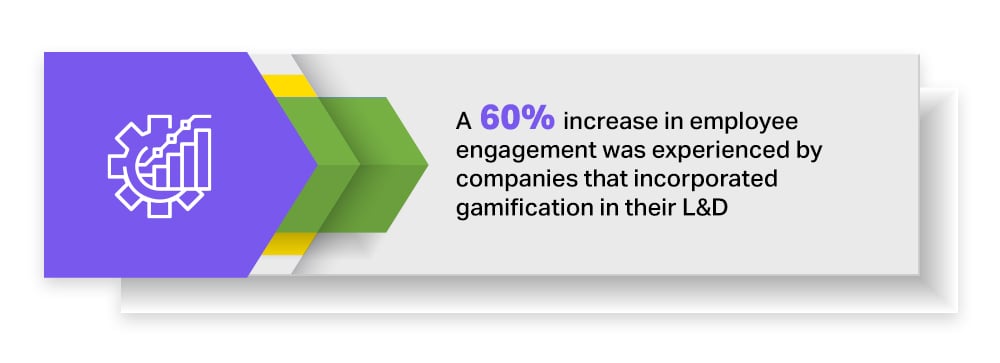
Leaderboards and badges help in
-
Striking healthy competition between teammates
-
Motivating employees to actively learn to be on top of the leaderboard
-
Instilling a positive spirit of achievement and recognition
-
Boosting learner’s confidence through rewards in the form of badges
-
Improving workplace engagement
Merge learning and AI
AI has wide potential that has brought a paradigm shift in workplace learning. L&D professionals can leverage AI to make learning seamless and more result-driven. Artificial Intelligence helps in saving time and can tailor learning to an employee’s requirements.
From onboarding to skill-based learning, it can be a helping hand in enhancing learning. Moreover, advanced LXP like Disprz also enables L&D to send automated email notifications for enrolling in new courses and reminders to ensure employees do not miss out on any course.
Focus on blended learning
Asynchronous and synchronous are two effective ways of delivering workplace learning opportunities. Some businesses are still in a dilemma of making a choice between the two. However, why choose one when you can blend both to provide more inclusive employee learning?
For instance, you have implemented a new prospecting software for the Demand Gen team. So you can provide a demo in person and use a digital learning platform like LXP to share use cases on how to use the software effectively.
Blended learning provides hand on-experience and gives employees the flexibility to access learning materials in their time of need. The L&D can acquaint the employees with a concept in a synchronous setup and elaborate it further in detailed courses on one learning system with practical tasks to help them practice what they’ve learned.
Create a multi-sensory learning experience
Lengthy pool of written content often fails to capture the employee’s interest. Hence it is pivotal to weave in auditory, visual, and kinesthetic media to have a tactile learning experience. Appeal to more than one learner’s senses to increase the possibilities of absorbing and retaining information.
Below are a few ways to create multi-sensory learning experiences
-
Create compelling videos with quizzes to propel employees to think and use their knowledge
-
Create long and short-form blogs with visually appealing images and infographics
-
Create thought-provoking assessments by putting employees in challenging situations
-
Conduct live sessions and make them interactive with gameinar elements like polls, quizzes and roulette wheel
-
Encourage engagement by creating a collaborative learning platform where employees can learn from each other
Dig deep into learning analytics metrics
Until now, with an LMS platform; some companies only touched the surface by focusing on enrollment and completion rates. However, to get the best ROI out of the learning initiatives, it is essential to measure all aspects of learning and development.
A modern LXP can help in conducting learning analytics to understand the impact of the learning programs. You can amass useful data that can help you measure various metrics such as
-
Course enrollment success rate
-
Course dropout
-
Skill gap (at the organization, team, and individual level)
-
Role-fitment score
-
Learning engagement level
-
Knowledge to performance conversion level
-
Stakeholder satisfaction level
-
Impact on organization performance.
By analyzing these metrics, you can identify the roadblock that is holding you back from reaching your learning goals and address the improvement areas to achieve more success.
2022’s workplace learning mistakes to avoid in 2023
A small mistake in delivering workplace learning can result in a significant decline in employee engagement, productivity, and business performance. Below are 2022’s most common workplace learning mistakes that you must consider avoiding in 2023.
Turning a blind eye to content strategy
Content is a vital component while designing learning and development programs. Not having a well-planned strategy can lead to disappointing L&D outcomes. Hence in 2023, ensure you have a content strategy in place to gain control of your content’s quality, effectiveness, delivery and relevance.
Here are a few tips for impactful content strategies
-
start by understanding business priorities and, based on that, conduct a need analysis to understand what kind of content is required
-
Create a detailed content plan that outlines the platform, resources, and tools you will use to curate and present the content
-
Determine in which format you will present the content to make it engaging for the learners
-
Create measurable course goals
-
Streamline all the content on one platform
-
Avoid overload of information
-
Make sure the content is personalized in terms of business goals and individual aspirations
-
Opt for a learning experience platform that integrates with various content providers
Making onboarding a one-day event
Most companies complete onboarding in a day or a week. In such cases, it becomes overwhelming for a new hire to digest a lot of information in less time. The initial training in the form of onboarding needs to be well-planned.
Here are a few things you can consider for creating an impactful onboarding experience.
-
Acquaint the new employee with the company’s policies and procedures through pre-onboarding
-
Make onboarding a blended experience by adopting the 70-20-10 model
-
Create 30-60-90 days onboarding process by leveraging drip journeys
-
In the first 30 days, the training should focus on familiarising the hire with the role, responsibility, product, USP, competitors, and teams, as well as various stakeholder
-
The next 30 days should be dedicated to putting into action what the employees learn and have a detailed analysis of the on-the-job performance.
-
Based on the analysis, further training can be planned.
-
By the third month, the employee should start working independently on the different projects.
Failure to link learning objectives to business goals and priorities
The main agenda for investing in employee learning is to improve employee performance to achieve business goals. Hence the learning objectives should be aligned with the priorities and the goals of a business. If you’ve not done it yet, ensure you do not make this mistake in 2023.
Here are the steps you can follow to link learning objectives with business goals
-
Coordinate with the top management and find out what are the business agendas for the year
-
Understand how different teams need to contribute to that goals
-
Identify the skills and competencies required
-
According create learning objectives and align them to organizational objectives
Assuming the learning programs are correct and current
One of the major mistakes that most L&D professionals make is assuming that the current learning and development programs are effective. Well, workplace learning trends and data aren’t evergreen. They keep changing; hence it is important to ensure your learning and development initiatives are updated.
So
-
Check if the data and statistics used are current and relevant
-
Revisit the training materials in regular intervals and ensure they are fresh and appealing
-
Make sure the new finding in your fields reflect in the training programs
-
Conduct polls to check if your learners like the content
Using an outdated learning technology
Learning technologies make a big difference in providing workplace learning and scaling it. Learning technologies are evolving at an exponential pace, yet most L&D professionals are still stuck with age-old technologies like content management systems and learning management systems that fail to stand the test of time.
So:
-
Research the modern technologies that are currently popular in the L&D space
-
Find out which features are missing in your current learning solution and what you will require to develop successful learning programs for your organization. For instance, if you are using an LMS, it won’t give you the flexibility to personalize like an LXP. Therefore based on the capabilities, you require to update your workplace learning system.
-
Determine if your current learning technology provides opportunities to scale, personalize and evaluate L&D initiatives to ensure learning success. If not, then move beyond it.
Not getting buy-in from managers
Most L&D professionals make the mistake of not involving managers in the learning process. Well, without the manager’s buy-in is key to getting the employees’ participation and commitment. Managers know what their team members do each day, so it is important to involve them in the employee learning process.
Therefore
-
Make managers a part of the L&D strategy development for their teams
-
Coordinate with the managers to understand the team’s strengths and weaknesses
-
Ask them to assess their employee’s performance
-
Keep them updated about their team’s learning progress
-
Offer a system where managers can directly give feedback and coach their team members
Conclusion
Workplace learning is critical for both the employees’ and the company’s growth. It has repeatedly proven to be beneficial for sharpening the skill set of the employees. All it needs is the right strategy, technology, and execution to be truly impactful. Smart technology like LXP has been helping many organizations for converting their strategies into lucrative results.
For instance, using Disprz LXP, a Global consumer goods company, could drive a more engaged workforce and increase its organizational performance. With this intuitive technology, they could understand the current skill levels and scope for improvement for different employees to drive business impact.
Using an advanced AI, they could automatically create personalized learning journeys that provided learning recommendations based on the employee’s proficiency levels. They could create an engaging user experience by showing employees their progress as they learn. Its skills analytics allowed the company to visualize workforce skills and track the skills it needs for the future. Moreover, it provided real-time progress on skilling, engagement, and adoption, allowing the company to spot opportunities and risks within its workforce.
Looking to revolutionize your L&D strategy in 2023? Try Disprz




